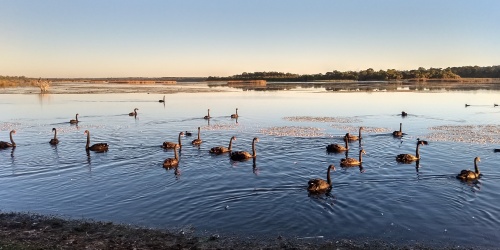
Adrian Pinder undertaking a bird survey in Lake Warden System Ramsar Site. Photo by Fiona Felton/DBCA
Western Australia has both nationally and internationally recognised wetlands of importance. Listing wetlands of importance help to identify and protect the wetland values. Nationally important wetlands are recognised under the Directory of Important Wetlands Australia and Internationally significant wetlands are recognised under the Ramsar Convention.
Internationally and nationally important wetlands in Australia are listed on the Australian Wetlands Database. More information about wetlands, including links to educational resources, publications and a list of Australian wetland education centres, is located on the Communication, Education, Participation and Awareness Program page.
Ramsar Wetlands (internationally important wetlands)
The Ramsar Convention is an international treaty on the conservation of important wetlands. Australia has 67 Ramsar sites, covering more than 8.3 million hectares. Being a signatory to the Ramsar Convention, Australia has undertaken to ensure our internationally important wetlands are conserved.
The federal Environment Protection and Biodiversity Conservation Act 1999 (EPBC Act), protects Australia's Ramsar wetlands by applying consistent management principles and arrangements between the Australian Government and the states. Any activity that may have a significant impact on a Ramsar wetland goes through a rigorous environmental assessment and approvals process under the EPBC Act.
There are 12 Ramsar wetland sites in Western Australia. The Department of Biodiversity Conservation and Attractions has the lead role in reporting on Ramsar wetlands to the Australian Government and recommending suitable wetlands for nomination on the List of Wetlands of International Importance via the Australian Government and the Ramsar Secretariat. This process involves consulting with key stakeholders and preparing nomination documents containing details of the values and other features of each wetland.
Directory of Important Wetlands (nationally important wetlands)
As a key part of their commitment to recognising Australia's most important wetlands, all state, territory and commonwealth governments have jointly compiled a Directory of Important Wetlands in Australia (DIWA).
The Directory identifies more than 800 nationally important wetlands and provides a substantial knowledge base of what defines wetlands, their variety, and the many plants and animals that depend on them. It includes information about their social and cultural values, and some of the benefits they provide to people. It is a valuable tool for managers and others interested in Australia's important wetlands.
Wetlands are identified as nationally important if they:
- provide a good example of a wetland type occurring within a biogeographical region in Australia
- play an important ecological or hydrological role in the major functioning of a major wetland system/complex
- provide important habitat for animals at a vulnerable stage in their life cycles, or a refuge when adverse conditions (such as drought) prevail
- support at least one per cent of the national populations of any native plant or animal species
- support nationally threatened (endangered or vulnerable) plant or animal species, or ecological communities
- are of outstanding historical or cultural significance
Western Australia has 120 nationally important wetlands and wetland systems listed in the Directory covering more than 2.5 million hectares.
Most of these wetlands occur within existing or proposed reserves managed by The Department of Biodiversity, Conservation and Attractions. Some occur on private property or pastoral lease, or lands for other purposes so their conservation depends on community assistance through programs such as Landcare.




